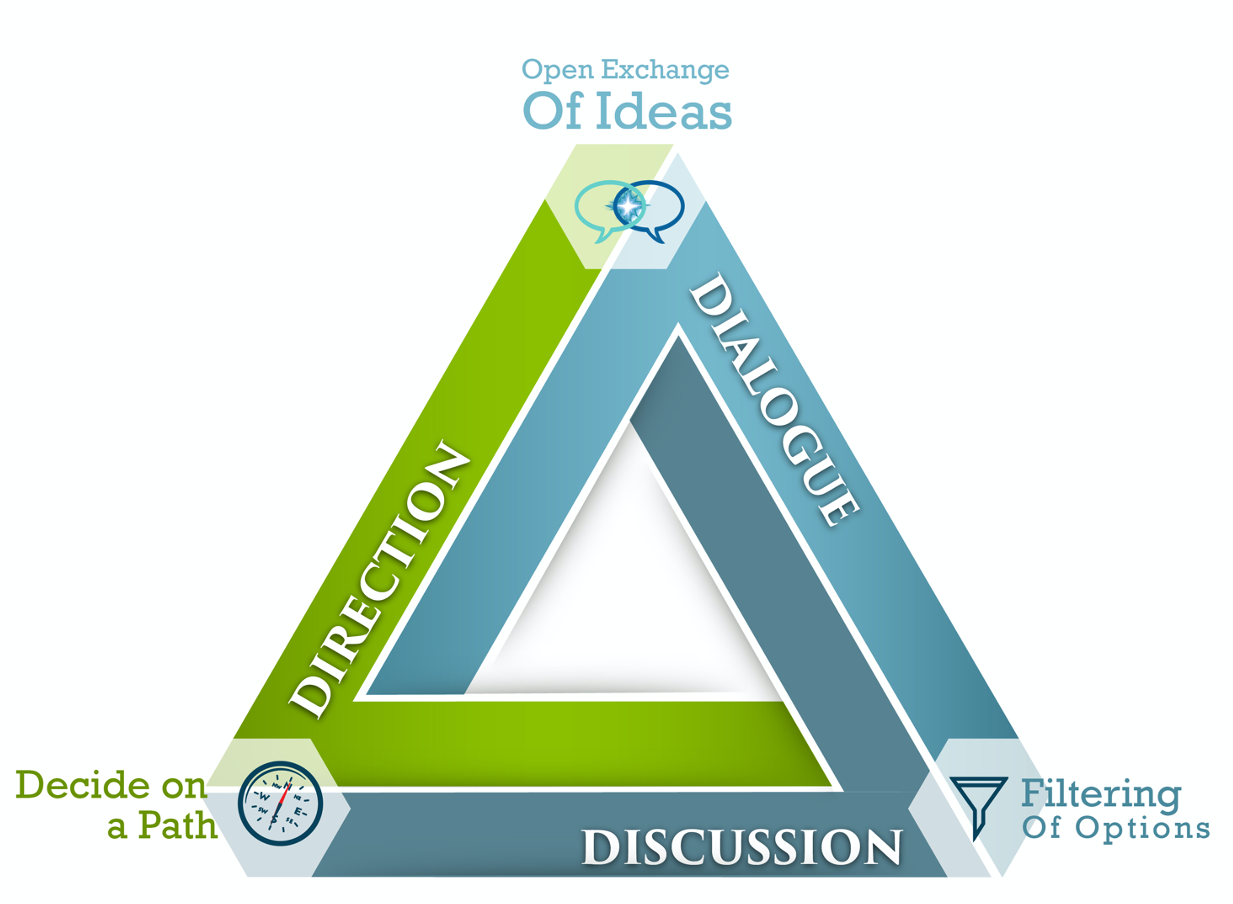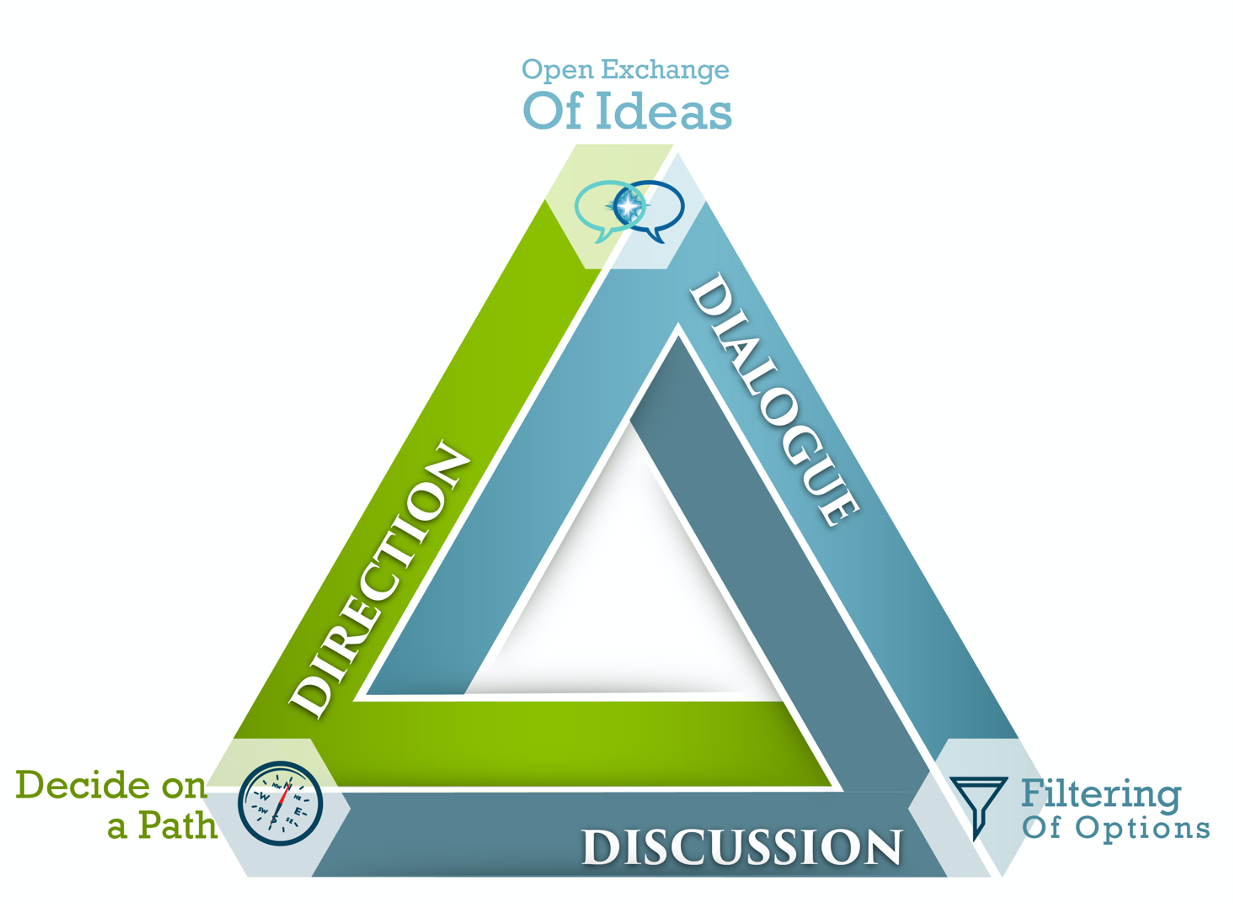A business is only as good as its conversations. Think about it for a moment: every step of progress your business takes, from establishing mission and vision, to creating a new product offerings, to servicing customers, all flows through conversations. When we think of ways to improve the business, how often does “have higher quality, more efficient conversations” factor in? Rarely? But it should.
During the past year, I’ve facilitated more than 200 virtual strategic conversations with executive teams on topics including organizational structure, decision making rights, succession planning, strategy development, innovation, competitive advantage, and collaboration. What we’ve learned in the virtual environment is that a higher level of preparation is required by participants than what they may be typically accustomed to. The good news is that these meaty and complex topics can be effectively discussed virtually if the teams invest time preparing for them and are hungry to get better.
A strategic conversation is defined as a verbal interchange of thoughts that result in new insights on how to achieve progress toward a common goal. The goal may be quantitative, qualitative or problem-solving in nature. The interchange, or giving and receiving of ideas, represents the intersection of thoughts, opinions, and assumptions that begins to create a shared understanding of the situation. Once you and your partner have established context, and are on the proverbial “same page,” you can begin to identify issues, explore options, and chart a path forward.
Strategic conversations are valuable in internal situations such as improving collaboration between different functional areas, setting strategic direction, and innovating for competitive advantage. They are also of value in external situations such as developing strategic partnerships with customers, strengthening relationships with suppliers, and understanding market dynamics.
The barriers to internal strategic conversations include the following:
1. Silos: Departments and levels are not on the in alignment because they are unaware of each other’s strategies.
2. Lack of buy-in: Inability to influence commitment without authority across functions.
3. Fire drills: Constantly reacting to the urgent, but unimportant matters that pop up.
Do you notice any of these barriers to strategic conversations within your organization?
The barriers to external strategic conversations include the following:
1. Transactional versus a partner relationship with customers, resulting in price-focused interactions.
2. Inability to ladder up within a client or account, leaving you stuck working with non-decision makers.
3. Selling product instead of facilitating the exchange of value, causing you to be shut out of future opportunities with key customers because you aren’t bringing anything new to the table.
Are any of these barriers to strategic conversations with customers negatively effecting your business?
To help you lead strategic conversations, I created the Strategic Conversation Framework which involves three phases: Dialogue, Discussion, and Direction.
Dialogue
The intent of the dialogue phase is to create a forum for the free flow of ideas, resulting in a shared understanding and meaning of the key issues. It is through dialogue that we learn of each other’s assumptions, ideas, and opinions, not so we can judge them, but so we can observe them to create something new. To that end, your mindset in the dialogue phase is exploratory, with the intent of “thinking together,” as opposed to the serial monologues that tend to dominate many conversations.
To engage in the Dialogue phase, begin with the following starter questions:
1. How would we describe this situation, challenge, or problem?
2. What are we trying to achieve–what’s our desired goal or outcome?
3. What issues are at the core of this situation?
Discussion
The intent of the discussion phase is to explore options to achieve the goal established for the conversation. It is in the discussion phase that we are analyzing the ideas generated through dialogue to examine them at a more granular level to determine how they can contribute to the achievement of the goal we’ve established. Here we are beginning to determine the pool of alternatives for reaching our goal by breaking down groups of ideas into potential pathways to move the situation forward.
To engage in the discussion phase, begin with the following starter questions:
1. What are your thoughts on the situation? Here’s what I think and why I think it. In what areas do we differ? Where is our common ground?
2. How can we combine several of these ideas to go from “either/or” to “and”?
3. What are 3-5 options for achieving our goal and the pros and cons of each?
Direction
The intent of the discussion phase is to explore options to achieve the goal established for the strategic conversation. The direction phase takes the input and insights generated through dialogue and discussion and configures them into a decision on which course of action to pursue. This decision takes the form of a strategic framework designed to communicate the chosen alternative to others and provide instruction on its implementation.
To engage in the direction phase, begin with the following starter questions:
1. Which alternative have we decided to select to meet our goal and why?
2. What are the 3-5 areas where we will focus our resources to enable us to reach our goal?
3. What are the roles (who), activities (what), outcomes (why), and time frames (when) that comprise our action plan?
Effective strategic conversations can transform business-as-usual into dynamic exchanges of insight that can take your business to the next level. All it takes is a willingness to prepare and a forum (virtual or live) to channel people’s thinking into conversation. If you see gaps in how your organization functions, it’s likely that the central gear of strategic conversations is missing. Without that gear, silos will stand, assumptions will prevail, and potential customers will be lost. If the foundation of a business is the sum total of its conversations, how solid is yours?
If you and your team would like to have more effective strategic conversations in 2021, let’s chat.

